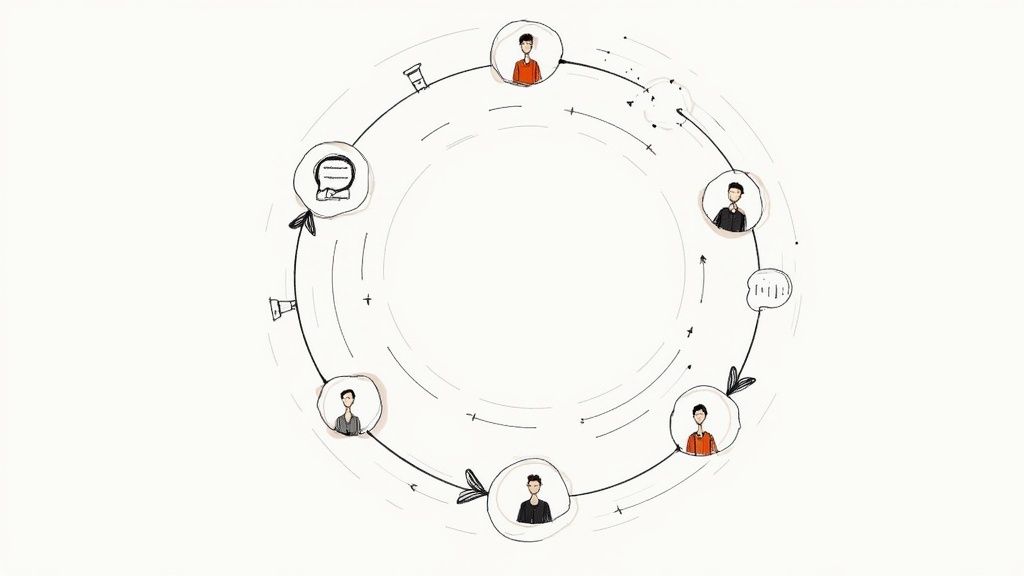How to Track Customer Satisfaction: Proven Tips
Unlock key metrics and expert tips on how to track customer satisfaction to boost retention and drive sales.
- 12 min read

How to Track Customer Satisfaction: Proven Tips
Why Tracking Customer Satisfaction Is Crucial For Your Business

Understanding customer sentiment is essential for business success. It’s a core element of thriving in today’s competitive landscape. Conversations with industry leaders consistently highlight the strong connection between actively tracking satisfaction and positive business results.
These results often include better customer retention, more referrals, and ultimately, greater revenue growth.
Companies that prioritize understanding their customer's feelings often outperform competitors by 2-3x in key growth metrics. By addressing customer needs effectively, businesses gain a significant market advantage. This proactive approach helps companies anticipate potential problems, transforming challenges into opportunities for improvement.
The Real Impact of Happy Customers
Imagine a company suddenly receiving many negative reviews. Without a system to track customer satisfaction, they might be blindsided and struggle to find the root cause.
However, a business actively monitoring feedback using tools like Customer Satisfaction Score (CSAT) or Net Promoter Score (NPS) can quickly identify the issue. This could range from a faulty product feature to a customer service lapse. This rapid response minimizes reputational damage and reduces customer churn.
Furthermore, tracking customer satisfaction isn’t just about damage control. It also highlights what's working well. By analyzing positive feedback and identifying trends, businesses can reinforce successful strategies.
This might involve expanding a popular product line, replicating effective customer service techniques, or enhancing well-received features. These improvements strengthen customer loyalty and drive ongoing growth. Tracking customer satisfaction directly impacts brand loyalty and customer retention. A Microsoft study found that 95% of customers consider customer experience important when choosing a brand. This emphasizes the need for effective customer satisfaction metrics like CSAT and NPS. These metrics help businesses understand customer sentiment and identify areas for improvement. CSAT, for instance, measures customer satisfaction after a specific interaction, while NPS gauges the likelihood of customers recommending a brand. By regularly monitoring these metrics, companies can enhance their customer service and improve the overall customer experience, ultimately boosting loyalty and revenue growth. More detailed statistics can be found here: Learn more about customer satisfaction metrics
The Hidden Price of Ignoring Feedback
Ignoring customer feedback creates hidden costs that significantly impact a business's bottom line. Lost customers, a damaged reputation, and missed opportunities for improvement are just a few of the consequences.
These costs, while difficult to quantify, are substantial and can erode a company's competitive edge over time. This highlights the importance of using effective tools and strategies for tracking customer satisfaction. Businesses must not only collect data but also use it to drive meaningful change.
Just as a ship needs a compass, businesses need customer feedback to guide them toward success. By understanding how to track customer satisfaction and implementing the right strategies, companies can build a customer-centric culture that promotes loyalty, fuels growth, and achieves long-term success.
Essential Metrics That Actually Reveal Customer Truth

Truly understanding customer sentiment goes beyond superficial metrics. It requires digging deeper to uncover the key indicators that successful businesses use to measure and improve the customer experience. It's about understanding not only what customers think, but also why.
Core Satisfaction Metrics: CSAT and NPS
Two popular metrics are the Customer Satisfaction Score (CSAT) and the Net Promoter Score (NPS). CSAT offers immediate feedback on specific interactions. It often uses a simple scale to measure satisfaction with a particular service or product. Imagine a customer rating their satisfaction after a support call, typically on a scale of 1 to 5.
NPS, conversely, measures overall loyalty and the likelihood of recommendations. Customers are asked how likely they are to recommend your company, providing a broader perspective on sentiment. This single question is a powerful snapshot of customer perception and can predict future growth.
Customer satisfaction metrics like NPS significantly impact business growth. Research from Bain & Company shows that 60% of companies actively measuring NPS report faster growth than competitors. Focusing on improving NPS boosts customer referrals and loyalty, directly contributing to expansion. These companies often see a 10% or more increase in referrals. For a deeper dive into the impact of customer service statistics, check out this resource: Learn more about the impact of customer service statistics.
Beyond the Basics: CES and Retention Rate
Beyond CSAT and NPS, other metrics provide even richer insights. The Customer Effort Score (CES) measures how easy it is for customers to interact with your business. A high CES often reveals friction points in the customer journey, highlighting areas for improvement. This could involve simplifying processes, improving website navigation, or providing better customer support. A complicated return process, for instance, could lead to a high CES, suggesting a need for streamlining.
Customer Retention Rate is another crucial metric. It tracks how effectively a business retains customers over time. A high retention rate signals strong customer loyalty and satisfaction, directly impacting revenue growth and stability. This metric reflects the long-term success of customer satisfaction initiatives. For tips on managing customer reviews, see: How to master customer reviews.
Choosing the Right Metric Mix
The best combination of metrics depends on individual business needs and goals. An e-commerce business might prioritize CSAT for individual transactions and NPS for overall brand loyalty. A SaaS company might focus on CES for onboarding and Retention Rate for subscription renewals. Analyzing customer journey touchpoints helps identify the most relevant metrics.
To help understand the nuances of each metric, let's look at a comparison:
Understanding Customer Satisfaction Metrics: A Comparison
This table highlights how each metric offers a unique perspective on the customer experience.
A Holistic View of Customer Satisfaction
It’s critical to view these metrics not in isolation but as interconnected pieces. Some, like a sudden drop in CSAT, provide immediate alerts. Others, like retention rate, reveal the long-term impact of efforts. Leading organizations balance immediate feedback with long-term loyalty trends. This balanced approach informs decisions that drive short-term improvements and sustainable growth. They understand that customer satisfaction is an ongoing journey of understanding and responding to customer needs.
Designing Feedback Systems People Actually Complete

Getting customer feedback is crucial for any business. But even the best system will fail if no one participates. Response rates are key. Leading companies are seeing 3-5x higher response rates simply by designing their feedback systems more effectively. Let's explore how they do it.
Timing Is Everything: When to Ask for Feedback
When you ask for feedback matters. Asking right after a key interaction, like a purchase or a customer service call, is often best. The experience is fresh in the customer's mind, making it easier for them to provide valuable insights. But be careful not to overdo it. Too many requests can lead to survey fatigue.
Finding the right balance is essential. A short CSAT survey after closing a support ticket, for example, provides valuable real-time data without being overwhelming.
Framing Questions For Honest Responses
How you ask questions greatly influences the answers you receive. Clear, concise, and unbiased questions are vital for accurate data. Avoid leading questions or complex jargon, which can confuse customers.
Focus on simple language and specific aspects of the experience. Asking “How satisfied were you with the speed of our service today?” offers more actionable information than a general “How was your experience?”. A mix of quantitative ratings (like 1-5 scales) and open-ended questions can provide both structured data and rich qualitative insights.
Choosing the Right Channels For Feedback
Not all customers prefer the same communication channels. Some like email surveys, while others prefer in-app prompts or SMS messages. Matching the channel to customer preferences can significantly boost response rates. Offering multiple options can also help.
Consider the context, too. A short SMS survey might work after a delivery, but a detailed email survey might be better after a complex purchase. First Contact Resolution (FCR) rate, the percentage of issues resolved on first contact, is a key indicator of customer satisfaction. A high FCR shows effective service, boosting satisfaction and loyalty.
For example, resolving 750 out of 1,000 inquiries on first contact yields a 75% FCR. This metric helps pinpoint areas for improvement in customer service, reducing churn and enhancing the customer experience. Focusing on FCR can significantly increase customer satisfaction and revenue. More detailed statistics can be found here: Explore Customer Satisfaction Metrics
You might also be interested in: How to Get Online Reviews With Email
Respecting Customer Time and Maximizing Data Quality
A feedback request's length and complexity should match the interaction's importance. While comprehensive data is valuable, long surveys can discourage participation. Balance gathering enough data with respecting customer time.
Clear progress indicators and incentives for completion can encourage participation. The goal is a seamless, user-friendly experience that encourages honest responses. This leads to better data and actionable insights, improving customer satisfaction and driving business growth.
Turning Raw Feedback Into Revenue-Driving Insights

Gathering customer feedback is the first step. The true value lies in understanding that data and transforming it into actionable strategies that boost revenue. Customer-centric companies recognize that data without analysis is meaningless. This section explores how these organizations convert satisfaction metrics into valuable business intelligence. It's about uncovering the story behind the numbers and using that narrative to enhance the customer experience.
Identifying Correlation Patterns
A key technique is identifying relationships between specific customer interactions and overall satisfaction. For example, a business might find a strong connection between extended wait times during support calls and lower CSAT (Customer Satisfaction) scores. By shortening wait times, they can likely improve overall customer satisfaction.
This analysis pinpoints areas with the biggest impact on customer happiness. It enables businesses to strategically prioritize improvements. Another example could involve correlating positive feedback on a particular product feature with a higher NPS (Net Promoter Score). This might signal an opportunity to promote or expand that feature in marketing materials.
Segmenting Feedback for Deeper Understanding
Segmenting feedback by different customer demographics provides a more nuanced understanding. A company might analyze feedback separately for new customers versus loyal, long-term customers, revealing different needs and preferences. This targeted approach allows for personalized changes that resonate with each group.
Understanding the unique drivers of satisfaction for different segments avoids generic solutions. A tailored strategy leads to more effective improvements. It helps businesses cater to specific customer needs, fostering stronger relationships.
Recognizing Emerging Issues Early
Analyzing feedback allows businesses to identify emerging issues before they become major problems. A sudden surge in negative reviews about a new product feature, for instance, acts as an early warning. This enables quick action, preventing widespread customer dissatisfaction.
This proactive approach saves valuable time, resources, and ultimately, protects the company's reputation. It allows businesses to address concerns quickly and efficiently, demonstrating responsiveness to customer feedback.
Combining Quantitative and Qualitative Data
The most impactful approach combines quantitative metrics (like CSAT and NPS) with qualitative data from customer comments. Numbers provide an overview, but comments reveal the "why" behind the scores. This provides a complete picture of customer sentiment.
For example, a low CSAT score coupled with complaints about slow website load times clearly indicates a specific area for improvement. This combined approach eliminates guesswork and focuses efforts effectively. It allows businesses to address the root cause of customer dissatisfaction, not just the symptoms.
Prioritizing Improvements Based on Business Impact
Successful businesses prioritize improvements based on their potential business impact, not just the number of complaints. While addressing all feedback is valuable, focusing on issues significantly impacting customer retention or revenue yields the best results. This strategic approach maximizes the return on improvement efforts.
By translating raw feedback into meaningful insights, businesses can turn customer satisfaction into a growth engine. This involves active listening, analysis, and responding to the customer's voice. Tools like kisReviews can simplify this process by centralizing review gathering, management, and showcasing. This provides crucial data for analysis and drives improvements in customer satisfaction. Learn more about using reviews to grow your business here: 10 Reasons Reviews Can Grow Your Business.
Closing The Loop: From Measurement To Action
Gathering customer satisfaction data is essential. However, truly successful companies go beyond simply collecting data. They take action based on what they learn. The key differentiator is execution. This means turning insights into concrete strategies, implementing those strategies, and then measuring the impact.
It's a continuous process of listening, acting, and improving. This creates a feedback loop that constantly refines the customer experience.
Building a Response Team and Establishing Accountability
High-performing organizations create cross-functional teams to address customer satisfaction insights. This approach ensures diverse perspectives contribute to finding solutions. It also promotes effective implementation across the entire organization. Customer satisfaction isn't just one department's responsibility; it's a company-wide endeavor.
Accountability is also vital. Each team member needs specific responsibilities and defined goals. This keeps everyone focused on the same outcome. It also prevents valuable insights from being overlooked or lost. When everyone is accountable, feedback translates into real change.
Setting Realistic Timelines and Addressing Quick Wins
Establishing realistic timelines is essential for maintaining forward momentum and achieving tangible results. Start by focusing on "quick wins." These are small, easily implemented changes that can have a noticeable positive impact on customer satisfaction. Early successes build momentum and demonstrate a commitment to acting on feedback.
Don't ignore systemic issues, however. While quick wins offer immediate benefits, addressing deeper, underlying problems is crucial for long-term improvement. This may involve process reviews, staff retraining, or technology upgrades. These changes prevent recurring customer dissatisfaction.
Communicating Changes and Measuring ROI
Closing the loop means communicating implemented changes back to the customers who provided the initial feedback. This shows them that their input is valued and encourages them to provide feedback in the future. A simple personalized email acknowledging their feedback and outlining the steps taken is often enough.
Finally, successful companies measure the ROI of their customer satisfaction efforts. This demonstrates the value of these initiatives and secures continued organizational support. Track key metrics like customer retention, revenue growth, or referral rates after implementing improvements. Customer churn rate is a particularly useful metric. It directly links customer satisfaction with revenue impact. Monitoring churn helps identify areas for improvement and proactively enhance customer satisfaction. Learn more about tracking customer satisfaction and its impact on revenue here: Explore Customer Satisfaction and Churn Rate. You might also be interested in: 10 Reasons Reviews Can Grow Your Business.
Closing the loop creates a virtuous cycle. Customer feedback drives continuous improvement, ultimately fostering customer loyalty and business growth. It’s a commitment to listening, acting, and constantly refining the customer experience.
Choosing the Right Customer Satisfaction Technology
Beyond the marketing buzz, selecting the right technology to track customer satisfaction is essential. This post explores the tools and platforms that are changing how businesses monitor customer sentiment, from simple surveys to sophisticated analytics.
Matching Technology to Your Business Needs
The most effective technology aligns with your specific business requirements. A small business with limited resources might find basic survey tools like SurveyMonkey or Google Forms a good starting point. These tools provide a cost-effective method for gathering initial feedback and measuring CSAT (Customer Satisfaction).
As your business expands, more comprehensive solutions such as Qualtrics or Medallia become relevant. These platforms offer advanced features, including in-depth reporting and analytics. These functionalities provide richer insights into customer sentiment, allowing for more targeted improvements. It's important to consider your existing technology as well. Your chosen customer satisfaction tool should integrate smoothly with your CRM and other platforms, preventing data silos and maintaining a streamlined workflow.
Sidestepping Implementation Issues
A frequent mistake is implementing new technology without a well-defined strategy. Before choosing a tool, clearly establish your goals and objectives. What specific metrics do you aim to track: NPS (Net Promoter Score)? CES (Customer Effort Score)? Understanding your goals ensures the technology effectively addresses your needs.
Another common pitfall is inadequate team training. Even the most powerful technology is ineffective if your team isn't proficient in its use. Investing in proper training maximizes the platform's potential and ensures data accuracy.
To help understand your options, the following table compares several customer satisfaction technologies.
Customer Satisfaction Technology Comparison: A detailed comparison of different technologies for tracking customer satisfaction, including features, benefits, and typical implementation costs.
This table reveals a range of solutions with varying levels of complexity and cost, allowing businesses to select the best fit.
Developing a Scalable Technology Strategy
An effective technology roadmap adapts to your business growth. Start with a foundational system and progressively incorporate more advanced features as needed, avoiding unnecessary initial expenses. For instance, a startup might begin with basic surveys and then implement AI-powered sentiment analysis as its customer base expands.
Turning Data into Action
Technology should ultimately drive action. Collecting data is only the first step; the real value lies in using that data effectively. Transform raw feedback into actionable strategies to improve customer experience and fuel business growth. This ongoing cycle of listening, acting, and improving is the key to achieving tangible results.
kisReviews simplifies the process of gathering and showcasing customer reviews. Our platform offers a centralized solution to collect, manage, and display reviews from key platforms like Google and Yelp. With features like QR codes, review links, and a no-code website widget, kisReviews empowers businesses to turn customer feedback into a powerful growth tool. Start leveraging customer feedback today with kisReviews!
